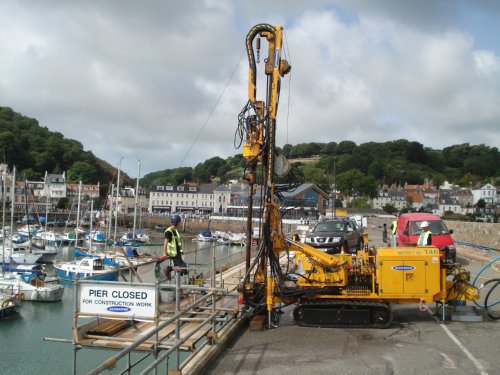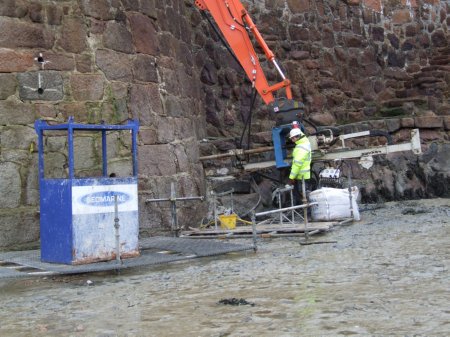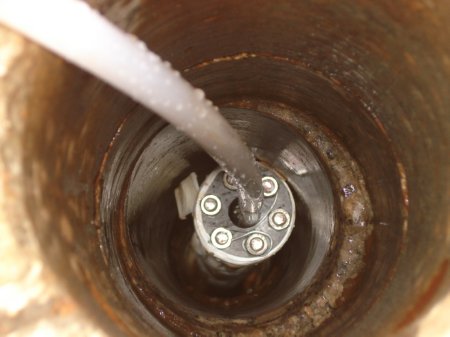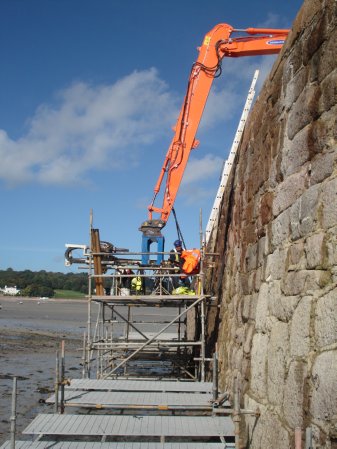 A challenging project to carry out stabilisation works to preserve the north and south piers of St Aubin Harbour and the breakwater at St Aubin Fort has just been successfully completed using an innovative method of mini-piling.
A challenging project to carry out stabilisation works to preserve the north and south piers of St Aubin Harbour and the breakwater at St Aubin Fort has just been successfully completed using an innovative method of mini-piling.
The project was carried out for Jersey Harbours by Geomarine Ltd
Ongoing damage over more than two centuries had gradually destabilised the piers and the breakwater to the extent that without stabilisation they would have been in danger of collapse, as happened in 1973 on a section of the breakwater.
Since 2001 consulting engineers Arup Rothwell have been monitoring the breakwater and the two pier arms in St Aubin Harbour. Having analysed wave patterns and forces in the area – and carried out tests – engineers have come up with a solution known as the Cintec System which is commonly used to stabilise ancient structures.
Elements of St Aubin harbour are 200-300 years old and traditional solutions were negated by the historical importance of the structures involved, general marine conditions, local sensitivities and the presence of a rare mollusc.
A discrete, flexible and low vibration solution was required. Geomarine installed Over 200 ‘Cintec’ anchors drilling over 2km. These are a drilled mini-pile, less than four inches in diameter, which have been used on historical monuments throughout the world, but never before for this application in the Channel Islands.
Speaking of the piling which proved highly successful, Mr Iain Barclay of Geomarine said: “First of all we drilled a 96mm hole of up to 17 m deep through the sea wall and underlining sands and gravels, which was cased to keep the hole free from sand and silt. We then installed a stainless steel 56 mm diameter anchor made up of six 8 mm stainless steel rods arranged in a hexagon around a plastic tube and held together with spacers. The anchor is then inserted into the cintec sock and the ends sealed, the anchor is then lowered into the drilled hole and the casing extracted. 
“We then pumped grouting down the plastic tube in the centre of the anchor, the sock expands to fill the 96mm hole size or up to 130mm to fill voids or joints in the wall, moulding itself to the shape of the hole. Horizontal anchors were also drilled securing the front and back walls together. Following installation of the anchors a pre cut plug is reinstated back into its original hole from which we cored out to start with, to form a hidden fix.”
He added that the rod structure was chosen in preference to a solid steel bar because the multi rod arrangement is more flexible allowing the pier to move with the tide and wave conditions.
The work required scaffolding to be erected and a drill rig put in place so that holes could be drilled in the masonry to insert the piles which ‘stitched’ the structures together and anchored them into the bedrock of the seabed.
Rotary drilling only was used to avoid vibration which could have damaged the historic structures.
Due to the severity and worsening condition work commenced on the breakwater to stabilise the structure before the winter before moving to the harbour’s north pier, sections of which was closed to the public for the duration of the works. As this work was being completed the rig moved to the south pier between the boat hoist and German bunker.
Jersey Harbour’s Technical Services Manager, Ray Hine, said “The stabilisation works have ensured that St Aubin Harbour and the Fort remain safe for future generations to enjoy.”
St Aubin was the main port of the Island’s commercial trade from the 17th to the early 19th century. The piers, which are proposed Sites of Special Interest, date from the 1760s with additions completed up to 1819, while work first commenced on the breakwater at St Aubin’s Fort in the 1680s. They are built of massive, dry-jointed granite masonry with parapet walls on the seaward sides.
The architectural heritage consultant for the scheme, Antony Gibb, said St Aubin Harbour and Fort rank among the Island’s greatest architectural and engineering achievements.






